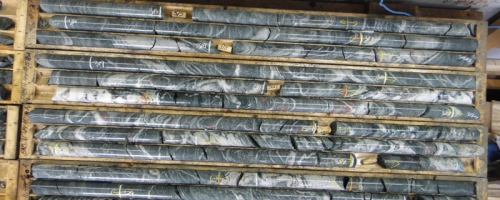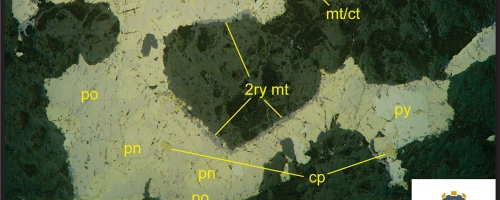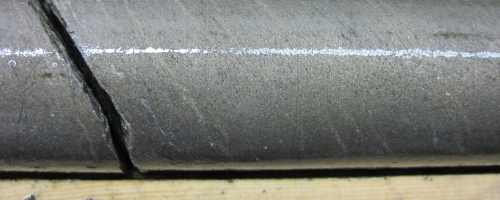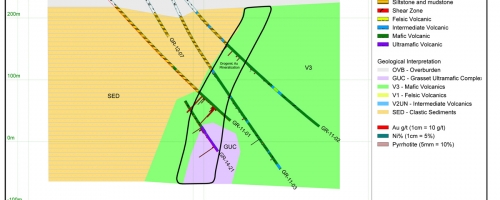Mineralization
The scale and geological setting of the Grasset Property provides multiple exploration opportunities for Balmoral. The initial focus of exploration on the Property was the 20+ kilometre long section of the Sunday Lake Deformation Zone which crosses the property and a similar stretch of the Lower Detour Deformation Zone which crosses the southern portion of the property. The Sunday Lake Deformation Zone hosts the multi-million ounce Detour Gold Deposit 80 kilometres to the west and is one of four principal regional scale fault systems which cuts across the Abitibi greenstone belt in Quebec.
Subsequent exploration has led to the discovery of a new nickel-copper-PGE system on the property, the first of its kind recognized in the belt. In addition, work by Balmoral and previous operators has indicated excellent potential in several locations on the property for the discovery of zinc-copper-(gold-silver) VMS mineralization similar to that observed to the SE in the Mattagami area and to the SW at Selbaie.
Nickel-Copper-PGE Mineralization
In 2012, while following up the discovery of the Grasset Gold occurrence (see below), Balmoral discovered a zone of nickel-copper-PGE mineralization within the basal portion of a largely untested sequence of ultramafic rocks (the Grasset Ultramafic Complex or GUC). Hole GR-12-09, located approximately 1,000 metres east of the Grasset gold discovery, intersected a 10 metre wide zone of disseminated pyrrhotite, pentlandite and minor chalcopyrite mineralization at the base of the GUC. This sulphide zone returned an intercept of 0.51% Ni, 0.09% Cu, 0.15 g/t Pt and 0.33 g/t Pd over 9.17 metres, including a high-grade interval of 1.34% Ni, 0.17% Cu, 0.16 g/t Pt and 0.54 g/t Pd. The magmatic nature of this mineralization was recognized, despite heavy structural overprinting and a follow-up program designed.
Geophysical work in 2013 along the southern portion of the GUC set the stage for the discovery in early 2014 of an extensive zone of high-grade magmatic nickel-copper-PGE mineralization at the southern end of the complex. Three mineralized “horizons”, paralleling the contacts of the vertically dipping GUC, host disseminated to locally net textured style sulphide mineralization. The upper of these three horizons (H3) hosts broad (20 to 100 m) intercepts of high-grade mineralization which can be traced for over 500 metres along strike and to vertical depths of 400 metres. Moderate to heavily disseminated sulphide mineralization located along the lower contact of the intrusion (H1) can be traced for over 1,000 metres.
The H3 discovery shows good lateral and vertical continuity and while it has been metamorphosed and locally fault modified it appears to be magmatic in nature. Narrow massive sulphide intervals have been observed along both Horizon 1 at the base of the complex and Horizon 3 in association with the net-textured zones returning individual assays ranging from 2.5 to over 15% nickel. The very high nickel values in massive sulphide intervals speaks to the very high nickel tenor of the H3 mineralization. The H1 zone appears to have a lower nickel tenor, perhaps in response to contamination of the magma by footwall lithologies. Horizon 3 discovery hole GR-14-25 returned 45.28 metres grading 1.78% nickel, 0.19% copper, 0.42 g/t Pt and several subsequent holes have rapidly expanded on this discovery which is now one of the focal points of Balmoral’s activities.
Mineralization within GUC takes the form of disseminated, to net textured, to locally massive, fine to medium-grained, pyrrhotite>pendlandite>>chalcopyrite>>pyrite. Lesser quantities of millerite, chromite and magnetite (after chromite) have been observed in thin section. The sulphide minerals occur as sulphide aggregates separating variably altered olivine and pyroxene crystals. This simple mineralogy is similar to that observed in most productive magmatic nickel sequences worldwide. No metallurgical work has been undertaken so far on this new discovery but initial thin section examinations are supportive of the mineralization being typical of that associated with numerous producing nickel deposits.
Work in 2006 by a previous operator identified nickel-copper-PGE mineralization exhibiting similar Ni:PGE, Ni:Cu and Pt:Pd ratios at the northern end of the southern segment of the GUC. This area is approximately 8.3 kilometres northwest of the Horizon 3 discovery area and suggests similar mineralizing processes were active throughout the GUC. Follow-up drilling by Balmoral, in the area 6.0 to 8.3 km northwest of the H3 discovery, confirmed the presence of additional zones of nickel sulphide mineralization within the GUC opening the potential for the discovery of multiple zones of nickel-copper-PGE mineralization within the very sparsely drilled GUC. This would be in keeping with similar ultramafic hosted magmatic systems globally – an exciting opportunity for the Company which now controls 100% of the entire known extent of the GUC. Over 90% of the southern segment of the GUC has never been drill tested and the basal contact area of the northern segment is also virtually devoid of testing.
Nickel mineralization is typically best developed within the most mafic phase of the GUC which is a serpentinized peridotite. Peridotite is observed at the base of individual cycles within the GUC and typically grades up sequence into less olivine and more pyroxene rich lithologies. The strong net-textured mineralization is hosted by an olivine-rich “black” peridotite located in the upper part of the GUC. Sulphide bearing footwall veins cut down into the underlying pyroxenite/pyroxene-peridotite and locally exhibit strongly elevated Pd, Pt and Au grades.
Geophysical work to date has provided mixed results in targeting H3 style nickel sulphide mineralization. In general, save for the narrow massive sulphide horizons observed, the H3 mineralization is at best a very weak EM (electromagnetic) conductor – atypical of many nickel zones with similar grades. This combined with extensive overburden cover throughout the Grasset Property has masked the mineralization from historic airborne and ground surveys. Widely spaced I.P. (Induced Polarization) surveying, used extensively by the Company in targeting gold mineralization on the Detour Project, successfully delineated the GUC sulphide zones as well as sulphide-bearing footwall and hanging wall lithologies.
Gold Mineralization
Initial testing of the Sunday Lake Deformation Zone in 2011 intersected a promising zone of quartz-carbonate vein hosted gold mineralization. Hosted with mafic intrusive rocks immediately north of the contact between the mafic intrusive and a sequence of strongly deformed polylithic “Timiskaming-type” conglomerates, this zone returned an average grade of 1.66 g/t gold over 33.00 metres, including two high grade sections grading 6.15 g/t gold over 4.40 metres and 4.18 g/t gold over 5.00 metres. The location and style of mineralization is similar to that associated with a number of gold deposits in the Timmins and Val d’Or gold districts to the south and to the Detour Gold deposit along trend in Ontario.
Follow-up drilling in the immediate vicinity of the Grasset Gold discovery indicated the presence of an anastomosing quartz-carbonate vein system along this contact which appears to increase in intensity to depth. Additional drilling is warranted to test this discovery at depth and to continue to test the northern contact of the Sunday Lake Deformation Zone across the property.
Recent drilling of the Grasset Nickel discovery has intersected several styles of gold mineralization in the hanging wall and footwall to the GUC. A 21 metre wide zone of semi-massive pyrite and quartz veining returned an average grade of 0.66 g/t gold in a sheared zone located in the footwall. Strongly sericite-altered, sheared felsic volcanic rocks in the hanging wall to the GUC have returned a number of intercepts of anomalous gold mineralization which need to be examined in greater detail. During the winter of 2015 Balmoral intersected a narrow, very high-grade shear structure cutting the lower margin of the GUC which returned over 200 g/t gold over 0.47 metres. This style of mineralization may be similar to that associated with the nearby Fenelon gold zone.
Copper-Zinc VMS Mineralization
Work in 2006 and 2007 by previous property operators identified numerous areas of anomalous zinc-copper (gold-silver) mineralization associated with felsic volcanic rocks on the adjacent Fenelon Property near the northern end of the GUC. Recent drilling (2012) by the Company has identified narrow horizons of semi-massive pyrite with anomalous zinc and copper values in a potential exhalative horizon at the contact between felsic and mafic rocks of the Grasset Property. In the Lac Grasset area at the eastern end of the property, historic work has indicated the presence of a potential rhyolite dome which is associated with multiple airborne conductors, very few of which have been drill tested to date. With the Mattagami camp, which is home to several past deposits and one currently producing zinc-copper deposit, less than 30 kilometres from the Grasset Property, this style of mineralization is a third promising target type on the property.





